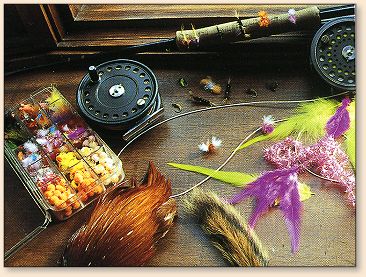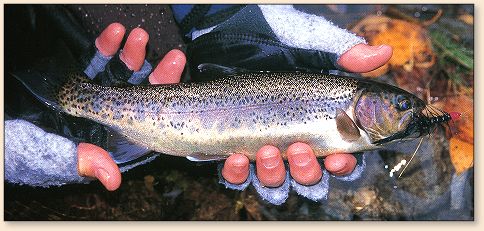Lake Erie Streams, Part 2
By Scott E. Smith
Fly Patterns
Caddisflies are very important in Lake Erie
tributaries, specifically in the Grand River
system, which includes Whitemans Creek and the
Nith River. Numerous species of caddis thrive
in the Grand's nutrient-rich waters. Many of
which are of the net-spinning variety. This is
likely why steelhead in this system has a penchant
not only for caddis larvae patterns, but skated
and dead-drifted caddis dries. Any ardent
steelhead-nut will tell you that a steelhead on a
dry is bliss; worth five steelhead taken subsurface.
Fish Elk Hair Caddis, small Stimulators and steelhead
waking dries in these streams when weather conditions
are mild in May, June and September.
Wet flies, Spey flies and soft hackle patterns are
best swung rather than dead-drifted because of the
inherent nature of emerging caddisflies. Mayflies
are also very important in Grand tributaries such
as Whitemans Creek, and size 12 or 10 nymphs from
the Hare's Ear family will produce nicely.

On Long Point Bay tributaries like Big Creek, caddis
are not quite as important Subsequently Hare's Ear
Nymphs and other general mayfly/stonefly representations
will produce well on a dead-drift presentation, as will
smallish, subtly coloured egg patterns.
Big Creek
Big Creek is the largest stream flowing into Long
Point Bay, and, historically, is the largest producer
of steelhead on Lake Erie. The estimated annual
return is approximately two-thousand fish.
Big Creek currently [as of this writing in 1999] has
a year-round open season for steelhead in the lowest
40 kilometers of the stream from the village of Lyndoch
to the mouth on Long Point Bay; and additional
10–kilometers of extended season water (trout opener
in April to December 31) begins at Lyndoch and ends
at Highway 3 in Delhi. This top 10 kilometer stretch
of Big creek fishes the best, with an abundance of
sandy-and gravely-bottomed riffles, run and pools
that remind you of Michigan's Rifle or Platte rivers.
Because the river rarely floods, this forty- to
fifty-foot-wide stretch of river is tight with foliage,
making the roll cast a valuable angling tool. Below
Lyndoch the stream opens up, but takes on a u-shaped,
deep channel configuration, which is difficult to read
and wade.
The steelhead recovery in this system (which is really
a river not a creek) is due to recent instream debris
removal and dam modifications by the OMNR and groups
such as the Delhi District Anglers Association.
Recent electro-fishing studies suggest that steelhead
juveniles have increased dramatically in this system,
and may even double the return in the not-too-distance
future.

Migratory browns are also available in Big Creek during
their annual summer migration. They can also be
successfully pursued by "flats fishing" the mouths
of Long Point Bay rivers with a sink-tip line and
a lake pattern such as a Clouser Deep Minnow. ~ Scott E. Smith
Continued next time.
Credits: From Ontario, Blue-Ribbon Fly Fishing Guide, published by Frank Amato Publications. We appreciate use permission.
Our Man In Canada Archives
|

